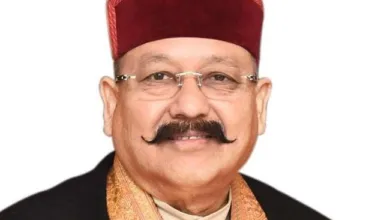Mukhjatra- recreating the zeitgeist of azadi

In literary accounts of historical events, there is always the danger of perpetuating a mythical legend. Literary retellings while closely adhering to facts can successfully take creative liberty for purposes of dramatisation of events that conjure evocative scenes from the past. Such retellings often leave lasting impressions of the zeitgeist of the moment, which is rarely matched by a dry historical narration of facts. One of the best examples that comes to mind is the telling of the story of the 1832 June Rebellion of Paris in Victor Hugo’s Les Misérables. We do not find many literary works in India that captures the zeitgeist of azadi ki ladai, especially that of thousands of jan andolans that were inspired by Mahatma Gandhi and other leaders across the country. A recently published play, Mukhjatra (2021), inspired by the Prajamandal Andolan of Tehri, comes close to recreating the zeitgeist of azadi and popular mobilisations against feudal colonial rule. The Mukhjatra is a play by Sunil Kainthola.
The Prajamandal Andolan in Garhwal culminated with the Maharaja Manbendra Shah of Tehri agreeing to dismantle his feudal kingdom and merge Tehri with the Indian Union. Shah had taken over after abdication by his father Maharaja Nagendra Shah in 1946. When India was being granted freedom from British rule in 1947 there was no guarantee that this would have led to democracy with universal franchise and end to feudalism. British rulers had decided to handover the territory they directly ruled to Indians represented by the Indian National Congress (INC), but this handover did not include a large part of the subcontinent ruled by 565 princely states. Along with the Independence of India, the British also ended the paramountcy over the princely states, which meant these princely states were free to become sovereign states or join Indian Union or Pakistan.
The task of persuading the princely states to join the Indian Union after 1947 was left to the persuasive power of the leaders of the INC led by Sardar Vallabhbhai Patel ably assisted by VP Menon who was the secretary of the Ministry of the States. Patel was remarkably successful in persuading the rajas and maharajas to choose democratic Indian polity. An important factor in the successful merger was a popular sentiment in princely territories in favor of joining a modern and democratic Indian Union. The groundwork for this was done by Prajamandal Andolans in princely states supported by the state chapters of the Congress. Some monarchs were reluctant to give up their dominions and privileges as absolute rulers. Among the last holdouts against the overtures were Kashmir, Junagadh, Hyderabad and the small princely state of Tehri in Garhwal.
The story of the merger of Tehri into the Indian Union is least known and discussed in mainstream history books. Historians of Uttarakhand have documented the Parajamandal Andolan of Tehri, especially the movement as a link in a chain of grassroots struggles going back to dhandaks in the colonial era. Dhandaks are largely non-violent protests that appealed to the sense of fairness and justice in the maharaja who in popular belief was seen to be the voice of God on the earth (bolandabadri).
The Prajamandal Andolan and its non-violent spirit, despite extreme provocation, is part of the genealogy of later grassroots struggles such as Chipko, Sharab Nahi Rozgar Do and the Uttarakhand Andolan of 1994 that led to the formation of the state on November 9, 2000. The lacunae in the collective consciousness of Uttarakhand concerning the Prajamandal Andolan and dhandaks have been ably filled by Kainthola with his play aptly titled Mukhjatra. The holdout by the Tehri king concerning the merger of his state with the Indian Union was not acceptable to the Prajamandal activists in Garhwal. They were further enraged by the king’s decision a month after Independence, to impose new taxes including in the muafadari of Saklana jagir, on the border between Tehri State and Dehradun that was historically exempt from tax collection by the Tehri State. When he sent his forces to collect the taxes Nagendra Saklani, a member of the extended family of the jagirdars of Saklana, organised the people- largely peasants, to resist the king’s soldiers. The peasants under Saklani’s leadership were successful in pushing the soldiers back and declared that Saklana Patti had joined the Indian Union. This rebellion set the stage for a bigger struggle to force the Maharaja of Tehri to accede to Indian Union.
Saklani with the help of other activists like Chandra Singh Garhwali, Paripoornanand Painuli, Devi Dutt Tiwari and others planned the liberation of Tehri from the Maharaja’s rule. The plan was to start at Kirtinagar on the banks of Alaknanda river that formed the boundary between Tehri and India after 1947. In January 1948, under the leadership of Nagendra Saklani, hundreds of people picketed the local sub-divisional offices of Tehri State. Faced by overwhelming popular sentiment the officers, police, and soldiers of the Maharaja surrendered on January 10, 1948.
In a letter written to comrades in Dehradun, on the day of the liberation of Kirtinagar, Saklani wrote “Tomorrow early in the morning we are planning to march to Tehri and will liberate it by January 15.” When the Prajamandal activists started their march towards Tehri from Kirtinagar, on January 11, they were confronted by reinforcement sent by Maharaja under Jagdish Dobhal. In the mayhem, Molu Ram Bhardari was shot, following which the enraged crowd chased Dobhal and his contingent. In the confusion, a panicked Dobhal shot Saklani. The two shots were fatal for both Bhardari and Saklani. As the passions were running high and it was feared that Dobhal and his soldiers would be lynched. The Prajamandal leadership at the spot handled the situation by putting Dobhal under arrest away from the crowd. Early next day, as preparations were being made for cremations of Bhardari and Saklani on the banks of Alaknanda plans suddenly changed with the arrival of Chandra Singh Garhwali from Kotdwar. He exhorted the andolankaris to take the last yatra of the martyrs- mukhjatra, to Tehri. This is what Saklani would have wanted- to liberate Tehri on January 15. The mukhjatra hiked from Kirtinagar to Tehri via Devprayag. As the andolankaris marched—carrying the bodies of Saklani and Bhardari, covered in blood-stained clothes crossing the ridges separating Bhagirathi valley from Alaknanda—streams of people joined. Reaching Tehri, the andolankaris symbolically liberated Tehri on January 14, 1948, by accepting the surrender of all the high officials of the princely state. The formal merger of the princely state of Tehri in the Indian Union took place in 1949.
Kainthola in his play makes us relive the three days of the mukhjatra that shook the feudal structure of Tehri. In the hands of a creative and musically inclined director, it has great potential to be produced as a multimedia production. The play can also be developed as a reenactment ecological theatre as an annual jatra from Kirtinagar via Devprayag to ironically the erstwhile capital of Tehri state that is submerged in the reservoir of Tehri dam.
(Kumar is an author and professor of communication at Cleveland State University)
Friday, 12 February 2021 | Anup Kumar





